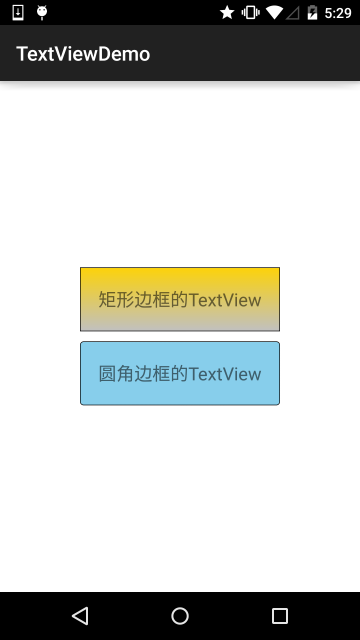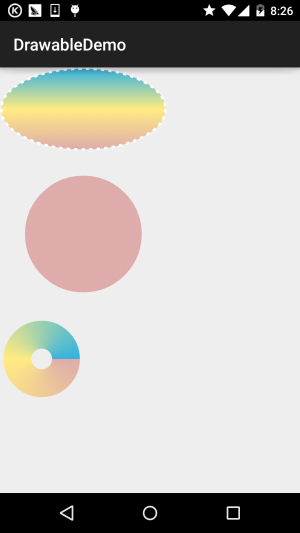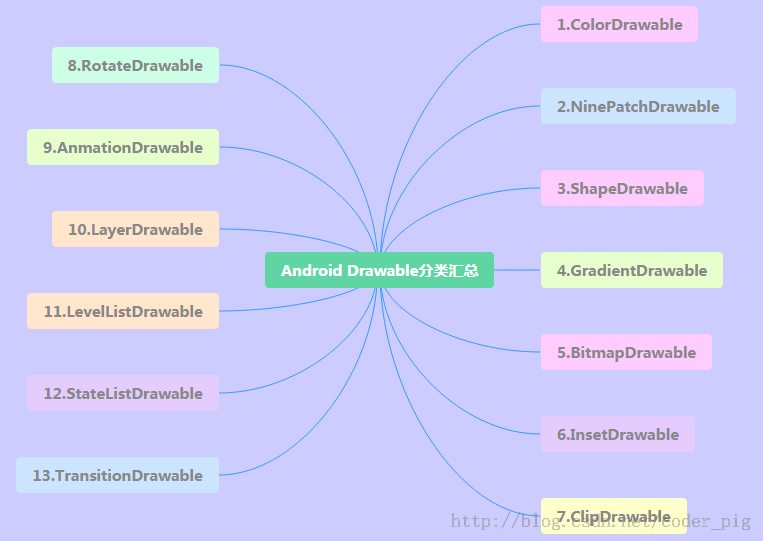本节引言:
从本节开始我们来学习Android中绘图与动画中的一些基础知识,为我们进阶部分的自定义打下基础!而第一节我们来扣下Android中的Drawable!Android中给我们提供了多达13种的Drawable,本节我们就来一个个撸一遍!
Drawable资源使用注意事项
- Drawable分为两种:一种是我们普通的图片资源,在Android Studio中我们一般放到res/mipmap目录下,和以前的Eclipse不一样哦!另外我们如果把工程切换成Android项目模式,我们直接往mipmap目录下丢图片即可,AS会自动分hdpi,xhdpi...!另一种是我们编写的XML形式的Drawable资源,我们一般把他们放到res/drawable目录下,比如最常见的按钮点击背景切换的Selctor!
- 在XML我们直接通过@mipmap或者@drawable设置Drawable即可比如: android:background = "@mipmap/iv_icon_zhu" / "@drawable/btn_back_selctor"而在Java代码中我们可以通过Resource的getDrawable(R.mipmap.xxx)可以获得drawable资源如果是为某个控件设置背景,比如ImageView,我们可以直接调用控件.getDrawale()同样可以获得drawable对象!
- Android中drawable中的资源名称有约束,必须是:[a-z0-9_.](即:只能是字母数字及和.),而且不能以数字开头,否则编译会报错: Invalid file name: must contain only [a-z0-9.]!小写啊!!!!小写!!!小写!——重要事情说三遍~
好的,要注意的地方大概就这些,下面我们来对Android中给我们提供的13种Drawable进行学习!
1.ColorDrawable
最简单的一种Drawable,当我们将ColorDrawable绘制到Canvas(画布)上的时候,会使用一种固定的颜色来填充Paint,然后在画布上绘制出一片单色区域!
1).Java中定义ColorDrawable:
ColorDrawable drawable = new ColorDrawable(0xffff2200); txtShow.setBackground(drawable);
2).在xml中定义ColorDrawable:
<?xml version="1.0" encoding="utf-8"?> <color xmlns:android="http://schemas.android.com/apk/res/android" android:color="#FF0000"/>
当然上面这些用法,其实用得不多,更多的时候我们是在res/values目录下创建一个color.xml文件,然后把要用到的颜色值写到里面,需要的时候通过@color获得相应的值,比如:
3).建立一个color.xml文件
比如:
<?xml version="1.0" encoding="utf-8"?> <resources> <color name="material_grey_100">#fff5f5f5</color> <color name="material_grey_300">#ffe0e0e0</color> <color name="material_grey_50">#fffafafa</color> <color name="material_grey_600">#ff757575</color> <color name="material_grey_800">#ff424242</color> <color name="material_grey_850">#ff303030</color> <color name="material_grey_900">#ff212121</color></resources>
然后如果是在xml文件中话我们可以通过@color/xxx获得对应的color值如果是在Java中:
int mycolor = getResources().getColor(R.color.mycolor); btn.setBackgroundColor(mycolor);
ps:另外有一点要注意,如果我们在Java中直接定义颜色值的话,要加上0x,而且不能把透明度漏掉:
int mycolor = 0xff123456; btn.setBackgroundColor(mycolor);
4).使用系统定义好的color:
比如:BLACK(黑色),BLUE(蓝色),CYAN(青色),GRAY(灰色),GREEN(绿色),RED(红色),WRITE(白色),YELLOW(黄色)!用法: btn.setBackgroundColor(Color.BLUE);也可以获得系统颜色再设置:
int getcolor = Resources.getSystem().getColor(android.R.color.holo_green_light); btn.setBackgroundColor(getcolor);
xml中使用:android:background="@android:color/black"
5).利用静态方法argb来设置颜色:
Android使用一个int类型的数据表示颜色值,通常是十六进制,即0x开头,颜色值的定义是由透明度alpha和RGB(红绿蓝)三原色来定义的,以"#"开始,后面依次为:
透明度-红-绿-蓝;eg:#RGB #ARGB #RRGGBB #AARRGGBB
每个要素都由一个字节(8 bit)来表示,所以取值范围为0~255,在xml中设置颜色可以忽略透明度,但是如果你是在Java代码中的话就需要明确指出透明度的值了,省略的话表示完全透明,这个时候就没有效果了哦~比如:0xFF0000虽然表示红色,但是如果直接这样写,什么的没有,而应该这样写:0xFFFF0000,记Java代码设置颜色值,需要在前面添加上透明度~示例:(参数依次为:透明度,红色值,绿色值,蓝色值)txtShow.setBackgroundColor(Color.argb(0xff, 0x00, 0x00, 0x00));
2.NiewPatchDrawable
就是.9图咯,在前面我们1.6 .9(九妹)图片怎么玩已经详细的给大家讲解了一下如何制作.9图片了!Android FrameWork在显示点九图时使用了高效的图形优化算法,我们不需要特殊的处理,就可以实现图片拉伸的自适应~另外在使用AS的时候要注意以下几点:
- 1.点9图不能放在mipmap目录下,而需要放在drawable目录下!
- 2.AS中的.9图,必须要有黑线,不然编译都不会通过,今早我的阿君表哥在群里说他司的美工给了他一个没有黑线的.9图,说使用某软件制作出来的,然后在Eclipse上是可以用的,没错是没黑线的.9,卧槽,然而我换到AS上,直接编译就不通过了!感觉是AS识别.9图的其中标准是需要有黑店或者黑线!另外表哥给出的一个去掉黑线的:9patch(.9)怎么去掉自己画上的黑点/黑线具体我没试,有兴趣可以自己试试,但是黑线真的那么碍眼么...我没强迫症不觉得!另外还有一点就是解压别人apk,拿.9素材的时候发现并没有黑线,同样也会报错!想要拿出有黑线的.9素材的话,需要反编译apk而非直接解压!!!反编译前面也介绍过了,这里就不详述了!
接着介绍两个没什么卵用的东东:
xml定义NinePatchDrawable:
<!--pic9.xml--> <!--参数依次为:引用的.9图片,是否对位图进行抖动处理--> <?xml version="1.0" encoding="utf-8"?> <nine-patch xmlns:android="http://schemas.android.com/apk/res/android" android:src="images/2021/07/13/04/2021071304483017767641." android:dither="true"/>
使用Bitmap包装.9图片:
<!--pic9.xml--> <!--参数依次为:引用的.9图片,是否对位图进行抖动处理--> <?xml version="1.0" encoding="utf-8"?> <bitmap xmlns:android="http://schemas.android.com/apk/res/android" android:src="images/2021/07/13/04/2021071304483017767641." android:dither="true"/>
3.ShapeDrawable
形状的Drawable咯,定义基本的几何图形,如(矩形,圆形,线条等),根元素是<shape../>节点比较多,相关的节点如下:
- ① <shape>:
- ~ visible:设置是否可见
- ~ shape:形状,可选:rectangle(矩形,包括正方形),oval(椭圆,包括圆),line(线段),ring(环形)
- ~ innerRadiusRatio:当shape为ring才有效,表示环内半径所占半径的比率,如果设置了innerRadius,他会被忽略
- ~ innerRadius:当shape为ring才有效,表示环的内半径的尺寸
- ~ thicknessRatio:当shape为ring才有效,表环厚度占半径的比率
- ~ thickness:当shape为ring才有效,表示环的厚度,即外半径与内半径的差
- ~ useLevel:当shape为ring才有效,表示是否允许根据level来显示环的一部分
- ②<size>:
- ~ width:图形形状宽度
- ~ height:图形形状高度
- ③<gradient>:后面GradientDrawable再讲~
- ④<solid>
- ~ color:背景填充色,设置solid后会覆盖gradient设置的所有效果!!!!!!
- ⑤<stroke>
- ~ width:边框的宽度
- ~ color:边框的颜色
- ~ dashWidth:边框虚线段的长度
- ~ dashGap:边框的虚线段的间距
- ⑥<conner>
- ~ radius:圆角半径,适用于上下左右四个角
- ~ topLeftRadius,topRightRadius,BottomLeftRadius,tBottomRightRadius:依次是左上,右上,左下,右下的圆角值,按自己需要设置!
- ⑦<padding>
- left,top,right,bottm:依次是左上右下方向上的边距!

4.GradientDrawable
一个具有渐变区域的Drawable,可以实现线性渐变,发散渐变和平铺渐变效果核心节点:<gradient/>,有如下可选属性:
- startColor:渐变的起始颜色
- centerColor:渐变的中间颜色
- endColor:渐变的结束颜色
- type:渐变类型,可选(linear,radial,sweep),线性渐变(可设置渐变角度),发散渐变(中间向四周发散),平铺渐变
- centerX:渐变中间亚瑟的x坐标,取值范围为:0~1
- centerY:渐变中间颜色的Y坐标,取值范围为:0~1
- angle:只有linear类型的渐变才有效,表示渐变角度,必须为45的倍数哦
- gradientRadius:只有radial和sweep类型的渐变才有效,radial必须设置,表示渐变效果的半径
- useLevel:判断是否根据level绘制渐变效果
代码示例:(三种渐变效果的演示):
运行效果图:

先在drawable下创建三个渐变xml文件:
(线性渐变)gradient_linear.xml:
<?xml version="1.0" encoding="utf-8"?><shape xmlns:android="http://schemas.android.com/apk/res/android" android:shape="oval" > <gradient android:angle="90" android:centerColor="#FFEB82" android:endColor="#35B2DE" android:startColor="#DEACAB" /> <stroke android:dashGap="5dip" android:dashWidth="4dip" android:width="3dip" android:color="#fff" /></shape>
(发散渐变)gradient_radial.xml:
<?xml version="1.0" encoding="utf-8"?><shape xmlns:android="http://schemas.android.com/apk/res/android" android:innerRadius="0dip" android:shape="ring" android:thickness="70dip" android:useLevel="false" > <gradient android:centerColor="#FFEB82" android:endColor="#35B2DE" android:gradientRadius="70" android:startColor="#DEACAB" android:type="radial" android:useLevel="false" /></shape>
(平铺渐变)gradient_sweep.xml:
<?xml version="1.0" encoding="utf-8"?><shape xmlns:android="http://schemas.android.com/apk/res/android" android:innerRadiusRatio="8" android:shape="ring" android:thicknessRatio="3" android:useLevel="false" > <gradient android:centerColor="#FFEB82" android:endColor="#35B2DE" android:startColor="#DEACAB" android:type="sweep" android:useLevel="false" /></shape>
调用三个drawable的activity_main.xml:
<LinearLayout xmlns:android="http://schemas.android.com/apk/res/android" xmlns:tools="http://schemas.android.com/tools" android:layout_width="match_parent" android:layout_height="match_parent" android:orientation="vertical"> <TextView android:id="@+id/txtShow1" android:layout_width="200dp" android:layout_height="100dp" android:background="@drawable/gradient_linear" /> <TextView android:id="@+id/txtShow2" android:layout_width="200dp" android:layout_height="200dp" android:background="@drawable/gradient_radial" /> <TextView android:id="@+id/txtShow3" android:layout_width="100dp" android:layout_height="100dp" android:background="@drawable/gradient_sweep" /></LinearLayout>
好的,就是那么简单~当然,如果想绘制更加复杂的图形的话,只用xml文件不远远不足的,更复杂的效果则需要通过Java代码来完成,下面演示的是摘自网上的一个源码:
运行效果图:
实现代码:
MainActivity.java:
public class MainActivity extends AppCompatActivity { @Override protected void onCreate(Bundle savedInstanceState) { super.onCreate(savedInstanceState); setContentView(new SampleView(this)); } private static class SampleView extends View { private ShapeDrawable[] mDrawables; private static Shader makeSweep() { return new SweepGradient(150, 25, new int[] { 0xFFFF0000, 0xFF00FF00, 0xFF0000FF, 0xFFFF0000 }, null); } private static Shader makeLinear() { return new LinearGradient(0, 0, 50, 50, new int[] { 0xFFFF0000, 0xFF00FF00, 0xFF0000FF }, null, Shader.TileMode.MIRROR); } private static Shader makeTiling() { int[] pixels = new int[] { 0xFFFF0000, 0xFF00FF00, 0xFF0000FF, 0}; Bitmap bm = Bitmap.createBitmap(pixels, 2, 2, Bitmap.Config.ARGB_8888); return new BitmapShader(bm, Shader.TileMode.REPEAT, Shader.TileMode.REPEAT); } private static class MyShapeDrawable extends ShapeDrawable { private Paint mStrokePaint = new Paint(Paint.ANTI_ALIAS_FLAG); public MyShapeDrawable(Shape s) { super(s); mStrokePaint.setStyle(Paint.Style.STROKE); } public Paint getStrokePaint() { return mStrokePaint; } @Override protected void onDraw(Shape s, Canvas c, Paint p) { s.draw(c, p); s.draw(c, mStrokePaint); } } public SampleView(Context context) { super(context); setFocusable(true); float[] outerR = new float[] { 12, 12, 12, 12, 0, 0, 0, 0 }; RectF inset = new RectF(6, 6, 6, 6); float[] innerR = new float[] { 12, 12, 0, 0, 12, 12, 0, 0 }; Path path = new Path(); path.moveTo(50, 0); path.lineTo(0, 50); path.lineTo(50, 100); path.lineTo(100, 50); path.close(); mDrawables = new ShapeDrawable[7]; mDrawables[0] = new ShapeDrawable(new RectShape()); mDrawables[1] = new ShapeDrawable(new OvalShape()); mDrawables[2] = new ShapeDrawable(new RoundRectShape(outerR, null, null)); mDrawables[3] = new ShapeDrawable(new RoundRectShape(outerR, inset, null)); mDrawables[4] = new ShapeDrawable(new RoundRectShape(outerR, inset, innerR)); mDrawables[5] = new ShapeDrawable(new PathShape(path, 100, 100)); mDrawables[6] = new MyShapeDrawable(new ArcShape(45, -270)); mDrawables[0].getPaint().setColor(0xFFFF0000); mDrawables[1].getPaint().setColor(0xFF00FF00); mDrawables[2].getPaint().setColor(0xFF0000FF); mDrawables[3].getPaint().setShader(makeSweep()); mDrawables[4].getPaint().setShader(makeLinear()); mDrawables[5].getPaint().setShader(makeTiling()); mDrawables[6].getPaint().setColor(0x88FF8844); PathEffect pe = new DiscretePathEffect(10, 4); PathEffect pe2 = new CornerPathEffect(4); mDrawables[3].getPaint().setPathEffect( new ComposePathEffect(pe2, pe)); MyShapeDrawable msd = (MyShapeDrawable)mDrawables[6]; msd.getStrokePaint().setStrokeWidth(4); } @Override protected void onDraw(Canvas canvas) { int x = 10; int y = 10; int width = 400; int height = 100; for (Drawable dr : mDrawables) { dr.setBounds(x, y, x + width, y + height); dr.draw(canvas); y += height + 5; } } }}代码使用了ShapeDrawable和PathEffect,前者是对普通图形的包装;包括:ArcShape,OvalShape,PathShape,RectShape,RoundRectShape!
而PathEffect则是路径特效,包括:CornerPathEffect,DashPathEffect和DiscretePathEffect可以制作复杂的图形边框...
关于这个GradoemtDrawable渐变就讲到这里,如果你对最后面这个玩意有兴趣的话,可以到:appium/android-apidemos
本节小结:
好的,本节就先学习ColorDrawable,NiewPatchDrawable,ShapeDrawable,GradientDrawable
四个Drawable先,当然这些都是炒冷饭,以前已经写过了,不过为了教程的完整性,还是决定在写一遍~另外,在写完基础教程后,以前写过的一些blog会删掉!

